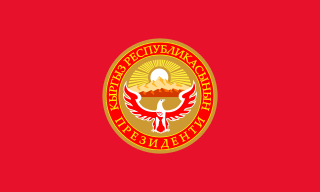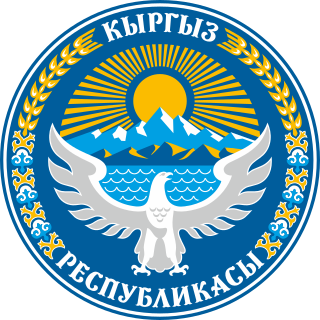This is a timeline of History of Kyrgyzstan . Each article deals with events in Kyrgyzstan in a given year.

Bishkek, formerly Pishpek and Frunze, is the capital and largest city of Kyrgyzstan. Bishkek is also the administrative centre of the Chüy Region. The region surrounds the city, although the city itself is not part of the region but rather a region-level unit of Kyrgyzstan. Bishkek is situated near the border with Kazakhstan and has a population of 1,074,075, as of 2021.

The history of the Kyrgyz people and the land now called Kyrgyzstan goes back more than 3,000 years. Although geographically isolated by its mountainous location, it had an important role as part of the historical Silk Road trade route. Turkic nomads, who trace their ancestry to many Turkic states such as the First and Second Turkic Khaganates, have inhabited the country throughout its history. In the 13th century, Kyrgyzstan was conquered by the Mongols; subsequently it regained independence but was invaded by Kalmyks, Manchus, and Uzbeks. In 1876, it became part of the Russian Empire, remaining in the USSR as the Kirghiz Soviet Socialist Republic after the Russian Revolution. Following Mikhael Gorbachev's democratic reforms in the USSR, in 1990 pro-independence candidate Askar Akayev was elected president of the SSR. On 31 August 1991, Kyrgyzstan declared independence from Moscow, and a democratic government was subsequently established.

The economy of Kyrgyzstan is heavily dependent on the agricultural sector. Cotton, tobacco, wool, and meat are the main agricultural products, although only tobacco and cotton are exported in any quantity. According to Healy Consultants, Kyrgyzstan's economy relies heavily on the strength of industrial exports, with plentiful reserves of gold, mercury and uranium. The economy also relies heavily on remittances from foreign workers. Following independence, Kyrgyzstan was progressive in carrying out market reforms, such as an improved regulatory system and land reform. In 1998, Kyrgyzstan was the first Commonwealth of Independent States (CIS) country to be accepted into the World Trade Organization. Much of the government's stock in enterprises has been sold. Kyrgyzstan's economic performance has been hindered by widespread corruption, low foreign investment and general regional instability. Despite those issues, Kyrgyzstan is ranked 70th on the ease of doing business index.

Kyrgyz is a Turkic language of the Kipchak branch spoken in Central Asia. Kyrgyz is the official language of Kyrgyzstan and a significant minority language in the Kizilsu Kyrgyz Autonomous Prefecture in Xinjiang, China and in the Gorno-Badakhshan Autonomous Region of Tajikistan. There is a very high level of mutual intelligibility between Kyrgyz, Kazakh, and Altay. A dialect of Kyrgyz known as Pamiri Kyrgyz is spoken in north-eastern Afghanistan and northern Pakistan.

Kyrgyzstan, officially the Kyrgyz Republic, is a landlocked country in Central Asia, lying in the Tian Shan and Pamir mountain ranges. Bishkek is the capital and largest city of the country. Kyrgyzstan is bordered by Kazakhstan to the north, Uzbekistan to the west, Tajikistan to the south, and China to the east and southeast. Ethnic Kyrgyz make up the majority of the country's 7 million people, followed by significant minorities of Uzbeks and Russians.

The Kyrgyzstan national football team, officially recognised by FIFA and AFC as Kyrgyz Republic, represents Kyrgyzstan in international football and is controlled by the Kyrgyz Football Union, a member of the Asian Football Confederation (AFC) and Central Asian Football Association.

The president of Kyrgyzstan, officially the president of the Kyrgyz Republic, is the head of state and head of government of the Kyrgyz Republic. The president directs the executive branch of the national government, is the commander-in-chief of the Kyrgyz military and also heads the National Security Council.

The chairman of the Cabinet of Ministers of Kyrgyzstan, formerly known as the prime minister of Kyrgyzstan chairs the Cabinet of Ministers of the Kyrgyz Republic.

Manas International Airport is the main international airport in Kyrgyzstan, located 25 kilometres (16 mi) north-northwest of the capital, Bishkek.

The Kyrgyz Football Union is the governing body of football in Kyrgyzstan. The organization controls the Kyrgyzstan national football team, Kyrgyzstan national futsal team and sponsors the Kyrgyz Professional Football League.

Kyrgyzstan has appeared in seven Summer Games and seven Winter Games as an independent state and has won 7 medals. It was previously represented by the Soviet Union team. In 1992, Kyrgyzstan competed as a part of the Unified Team, following the break up of the Soviet Union. Kyrgyzstan made its first appearance as an independent nation in the 1994 Winter Olympics and the 1996 Summer Olympics.

The Kirghiz Soviet Socialist Republic, also known as the Kyrgyz Soviet Socialist Republic or Kirgiz Soviet Socialist Republic, was one of the constituent republics of the Soviet Union (USSR) from 1936 to 1991. It was also known by the names Kyrgyzstan and Soviet Kyrgyzstan in the Kyrgyz language, and as Kirghizia and Soviet Kirghizia in the Russian language. Landlocked and mountainous, it bordered Tajikistan and China to the south, Uzbekistan to the west and Kazakhstan to the north. The Kirghiz branch of the Communist Party of the Soviet Union governed the republic from 1936 until 1990.

China–Kyrgyzstan relations are the bilateral relationship between China and Kyrgyzstan.
This page shows the Kyrgyzstan national football team's results in International Matches, as recognized by FIFA:
The Miss Kyrgyzstan is a national beauty pageant in Kyrgyzstan. The pageant was founded in 2009, where the winners were sent to Miss Universe.
The Military ranks of Kyrgyzstan are the military insignia used by the Armed Forces of the Republic of Kyrgyzstan. Kyrgyzstan is a landlocked country, and does therefore not possess a navy. Being a former Soviet state, Kyrgyzstan shares a rank structure similar to that of Russia.

The COVID-19 pandemic in Kyrgyzstan was a part of the worldwide pandemic of coronavirus disease 2019 caused by severe acute respiratory syndrome coronavirus 2. The virus was confirmed to have reached Kyrgyzstan in March 2020.

Sadyr Nurgojo uulu Japarov is a Kyrgyz politician who is currently serving as the president of Kyrgyzstan since 28 January 2021. He had previously served as the acting prime minister of Kyrgyzstan in the 2020 interim government following the resignation of President Sooronbay Jeenbekov. Japarov also became acting president of Kyrgyzstan after Jeenbekov's resignation but resigned himself on 14 November 2020 to run for the 2021 presidential election, where he was elected to succeed the acting president Talant Mamytov.
This article provides details of international football games played by the Kyrgyzstan national football team from 2020 to present.

A series of sporadic border clashes resumed between Kyrgyzstan and Tajikistan on 27 January 2022, following a series of clashes in 2021 between the two countries. These events took place before and during Russia's invasion of Ukraine that began a month before the second clashes.